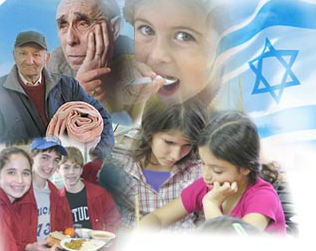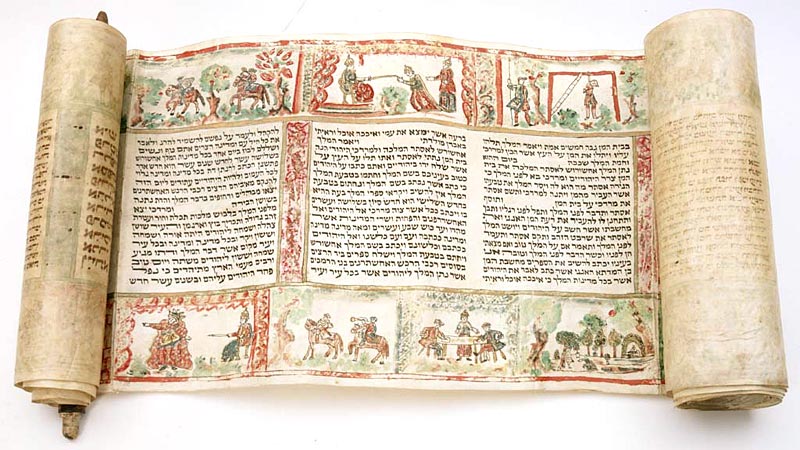| Printer Friendly Version

(Click on image)
|
|
|
|
 |
|
 |
Rabbi Avrohom Lipszyc |
Dear Friend,
Purim is traditionally a celebration of
The Mask. Children and adults alike dress in costumes and celebrate the holiday of Purim in festivity.
What lay behind this tradition of the mask?
For starters, the heroine of the Purim story is Queen Esther. Her Hebrew name was Hadassah, and yet she is known for her Persian name Esther. Esther also has a Hebrew meaning from the word
Astir, which means to hide. Additionally, the story of Purim is documented in the Book of Esther, which is the only book of the Torah that does not mention the name of G-d even once! Why? Because the story of Purim is hinted in the biblical verse of, "
Hastir astir... Hide I shall hide on that day..." Thus, on a spiritual level, Purim is all about revealing the higher
Hidden Light, which transforms from darkness itself.
A mask and a costume can serve as a way to either betray you or preserve you. Here is a story that tells the story of the mask very well:
Rabbi Gurarie, a chosid of Rabbi Shmuel of Lubavitch, was a very affluent business man, with many dealings in the city of Leningrad. When Rabbi Gurarie was in the city of Lubavitch he dressed like a chosid, however, when he went on his business trips to Leningrad he would dress like a modern day business man.
One day, Rabbi Gurarie thought to himself
I am lying to my Rebbe! I dress here like a chosid, while in Leningrad I dress like a modern day businessman... How dare I lie to my Rebbe?! I must present myself before my Rebbe honestly, for who I am when I am not amongst my fellow chassidim!
The next time that Rabbi Gurarie went into the Rebbe for a private audience he dressed as he did when he was in Leningrad. The Rebbe lifted his holy eyes in question for the meaning of this, and Rabbi Gurarie burst out in tears revealing to the Rebbe that this is how he dressed when he was in Leningrad, and he asked the Rebbe for forgiveness for fooling the Rebbe and dressing like a chosid in Lubavitch.
The Rebbe responded with, "
I know how you dress when you are in Leningrad. However, I thought that you were fooling them! Now, you tell me that you were fooling me..."
My friends, we all wear masks, and we all have our true appearance. The story of Purim is to remember which bis our mask, and which is our true appearance.
L'Chaim!
Your friend as ever,
Avrohom
|
|
|
Sources of Customs & Laws of Purim
 The observances related to Purim are based on the following quotation from the Book of Esther
"
And Mordechai wrote these things and sent letters to the Jews... to enjoin them that they should keep the fourteenth day of the month of Adar... that they should make them days of feasting and gladness, and of sending portions one to another, and gifts to the poor. And the Jews took upon themselves to do.... and upon their descendants, and upon all such as joined themselves unto them.... that they would keep these two* days according to the writing thereof and according to the appointed time, every year" (Esther 9:20-23:27).
*
Because the capital city of Shushan celebrated on the fifteenth, cities like Shushan, which have been walled since the days of Joshua, were to observe Purim a day later, on the fifteenth of Adar. That day is now called Shushan Purim. In Jerusalem, Purim is observed on the fifteenth of the month instead of the fourteenth.
|
|
Purim To Do List: Four Mitzvot

Megillah Reading
Both men and women are required to listen to the reading of the Megillah twice, Saturday, March 11th at night, and again on the following day, Sunday, March 12th during the daytime. Children should also be trained to attend the synagogue to fulfill this duty. Many people twirl "
groggers" (noise makers) whenever Haman's name is mentioned. This custom derives from the Biblical injunction to "
wipe out the name of Amalek" the first adversary to attack the Jews after the Exodus. (Haman was a descendant of the family of Amalek).
 Mishloach Manot
Mishloach Manot
Purim emphasizes themes of unity and friendship, which helped bring about the miracle, and are therefore commemorated by sending gifts of food to friends and family. To fulfill this obligation, one is to send a gift of at least two different kinds of ready-to-eat foods, to at least one person. These gifts should be sent through a third party, as it is called
mishloach manot (sending gifts) in the Megillah.
Join our annual
Purim Basket Fundraiser and

Sending Gifts To The Poor
Concern for the needy is a year-round responsibility for the Jew. However, special significance is added at the time of Purim, when we help needy people celebrate their own Purim, indicating that we are still a people united by a common bond. Mordechai and Esther decreed to celebrate Purim in this manner. The mitzvah is fulfilled by giving gifts to at least two needy people. Maimonides codified that one should spend more on the mitzvah of sending gifts to the needy, than on the other mitzvot of Purim. One should encourage even small children to fulfill this mitzvah.
Here is a link to an organization that will deliver your donation to the poor in Israel:
>charityforisrael.com<

Purim Meal
A fourth requirement of Purim observance is to "
Eat, drink and be merry". A festive family dinner should be held on Purim day. Customarily, the meal begins in the afternoon and continues into the evening.
**Join us at our Purim Masquerade Ball**
 Sunday, March 12, 2017 Sunday, March 12, 2017
hors devours ~6:00 PM
12407 Biscayne Boulevard
North Miami, Florida 33181
~
Costume Theme:
Disney Charatcers
~Your favorite hero/heroine or villain~
~
|
|
Hamantaschen Recipe
 Ingredients
Ingredients 4 eggs
1 cup sugar
1/2 cup oil
juice of one lemon
rind of 1 lemon, grated
1 tsp. vanilla extract
5 cups flour
2 tsps. baking powder
Fillings:
1 pound prepared poppy seed filling
or, 1 pound lekvar (apple or prune butter)
or 1 pound strawberry or apricot preserves
Preheat oven to 350
Grease cookie sheets.
Beat eggs and sugar. Add remaining ingredients, and mix well. Divide into four parts.
Instructions:
1. Prepare dough of your choice. Divide into four portions
2. On a floured board roll out each portion to about 1/8-inch thick. Using a round bicuit or cookie cutter cut 3-inch circles.
3. Place 1/2 to 2/3 teaspoon of desired filling in the center of each circle.
4. To shape into triangle, lift up right and left sides, leaving the bottom down and bring both side to meet at the center above the filling.
5. Bring top flap down to the center to meet the two sides. Pinch edges together.
6. Place on grease cookie sheet 1 inch apart and bake at 350 degree preheated oven for 20 minutes.
|
Services:
 Children's Party: 7:00 PM Children's Party: 7:00 PM
Megillah Reading: 7:45 PM
Sunday Morning, 3/12/17
 Shacharit:
9:00 AM
Megillah Reading:
9:30 AM
LOCATION:
Chabad Lubavitch of North Miami
12407 Biscayne Boulevard
North Miami, FL 33181
|
|
| |
|